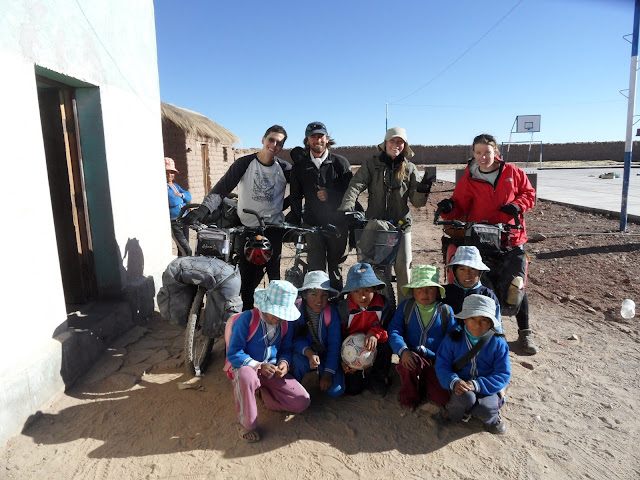The only thing worth mentioning about the boring way from Salinas is the crater, 38 km from town, which is right next to the road.

Amit managed to get us a closed room for the night, in the only room in the school of Villa Esperanza, thanks to the kindness of the only teacher, Osvaldo. Surprisingly, a French couple arrived there as well and slept with us in the school.

Héléne and Stéphane (altiplano.centerblog.net) are doing an unusual trip by foot from Quito, Ecuador to Ushuaia, Argentina. In order to cross the Salar de Uyuni, they bought bicycles in Oruro and plan to ride up to Uyuni, where they will sell the bikes and continue by foot. We had a pleasant evening together, communicating with a mixture of French and Spanish. The kids and their teacher arrived a bit after 9 AM, the time when the studies were supposed to start. They were afraid to approach us strangers at first, but when we offered them candies and cookies, they even agreed to be photographed with us.

Asphalt
This day´s ride was even more boring then the previous day, but after some 40 tiring km, the road became paved, right after Quillacas. It was still early when we got there, so we continued to Huari. At the beginning we were stalled quite a few times due to piles of soil that blocked the road. The wind that blew all day long until sunset also slowed us down.

It was already dark when we arrived to Huari, which is quite unattractive. After trying 2 hotels which were both closed, we ate a ridiculously cheap traditional dinner (10 Bs) in a restaurant. The nearby hotel was open when we finished eating, so we stayed there (25 Bs, no shower) and had yet another cheap dinner (10 Bs), because we were still hungry. The whole village was celebrating the religious holiday of San Juan with cheap fireworks, sausages and Coca.
Skipping to La Paz
We didn´t sleep well because of all the noise and got up very early. It then occurred to us that we could try and skip the ride on the busy and boring road to La Paz by bus. After a cookies breakfast, it was an easy and fast ride of 14 km until Challapata.

There we took the first bus to Oruro, which leaves every 30 minutes. It was crowded and suffocating in the bus, but we can´t complain as the 2 hours ride costs almost nothing (10 Bs). In Oruro we took the time to eat lunch in a restaurant (10 Bs), and then caught a bus to La Paz (15 Bs).

The bus was a bit bigger, but still suffocating. Somehow we survived the 3 hours ride, and arrived to La Paz at day light. We went straight to the Casa del Ciclistas, but unfortunately the host, Cristian, was away for a vacation. We settled for the nice 2* Alem Hotel (35 Bs). We plan to explore this interesting city, do some shopping and plan the last weeks of our trip. We have a flight back home from Lima in about a month at the end of July.
For more photos of this post click here


















































